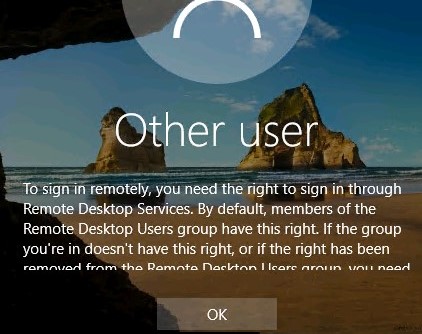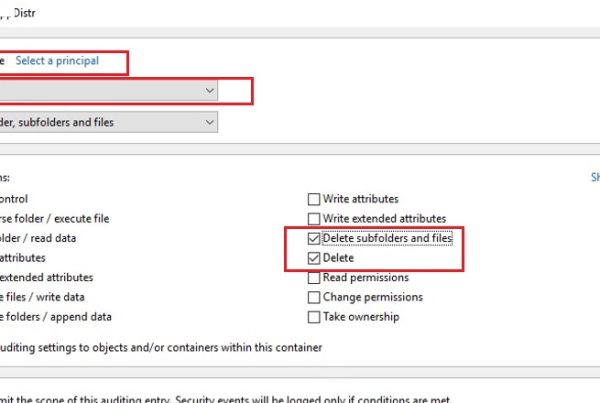WMI filters in Group Policy (GPO) allow you to more flexibly apply policies to clients by using different rules. A WMI filter is a set of WMI queries (the WMI Query Language / WQL is used) that you can use to target computers to which a specific group policy should be applied. For example, using the WMI GPO filter, you can apply a policy linked to an OU only to computers running Windows 10 (a policy with such a WMI filter won’t apply to computers with other Windows versions).
What are the WMI GPO filters used for?
Typically, group policy filtering using WMI (Windows Management Instrumentation) can be used when multiple domain objects (users or computers) are located in the flat AD structure instead of the separate OU, or if you need to apply group policies, according to the OS version, network settings, installed software or any other criteria that can be selected using WMI. When the client processes such a group policy, Windows will check its state for compliance with the specified WMI query, and if the filter conditions are met, the GPO will be applied to this computer.
WMI group policy filters first appeared in Windows XP/Server 2003, and are available up in the latest Windows versions (Windows Server 2019, 2016 and Windows 10, 8.1).
Create a New WMI Filter and Link it to a GPO
To create a new WMI filter, open the Group Policy Management console (gpmc.msc and go to Forest -> Domains -> corp.local -> WMI Filters. This section contains all WMI filters in tha AD domain. Create a new WMI filter (New).
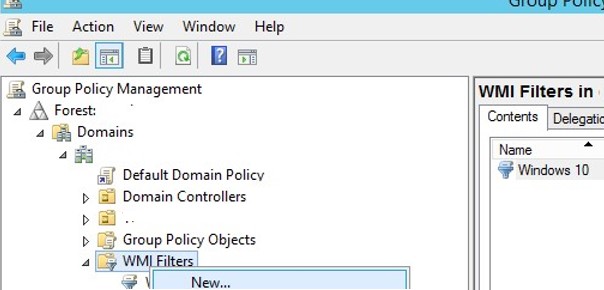
Type the filter name and its description (optional). To add a WMI query code to the filter, click the Add button, specify the name of the WMI namespace (by default, root\CIMv2) and specify the WMI code.
The following WMI query format is used:
Select * from <WMI Class> WHERE <Property> = <Value>
In this example, I want to create a WMI filter that allows to apply GPO only to computers running Windows 10. The WMI query may looks like this:
Select * from Win32_OperatingSystem where Version like "10.%" and ProductType="1"
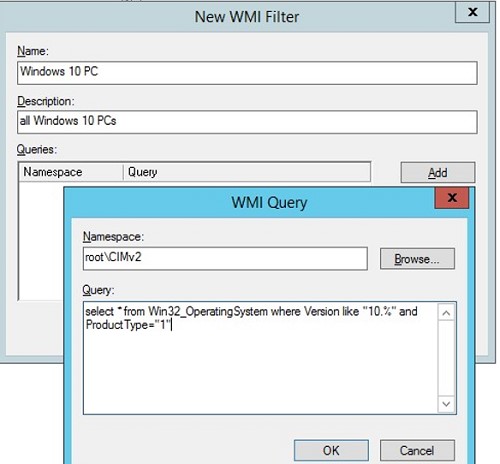
The created WMI filters are stored in the msWMI-Som class objects of the Active Directory domain in the section DC=…, CN=System, CN=WMIPolicy, CN=SOM, you can find and edit them using the adsiedit.msc.
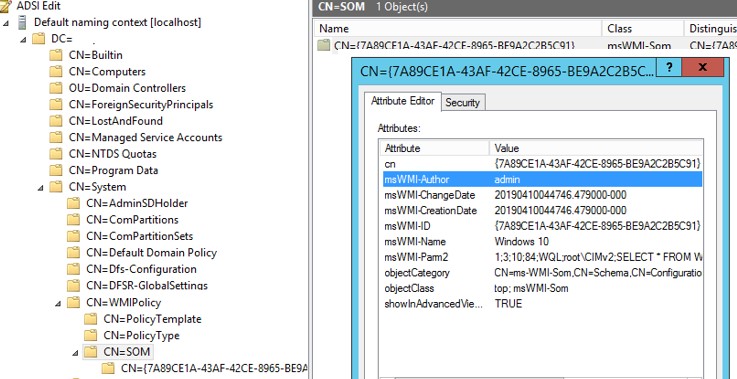
After you have created a WMI filter, you can link it to a specific GPO. Find the desired policy in the GPMC console and on the Scope tab, in the WMI Filtering section drop-down list, select your WMI filter. In this example, I want to apply the printer assignment policy only to computers running Windows 10.
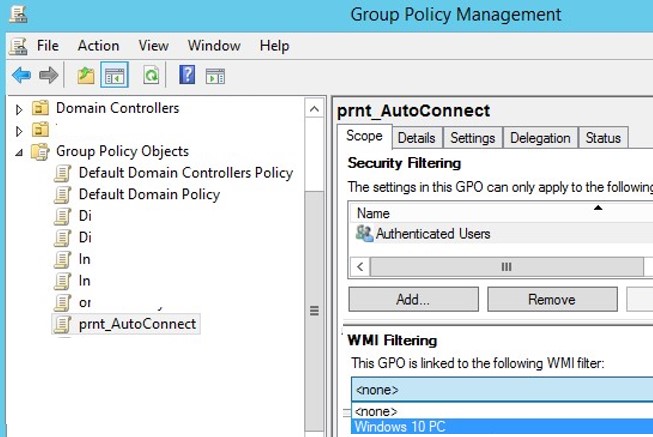
Wait for this policy to apply to clients, or update it manually with the command gpupdate /force. When analyzing the applied policies on the client, use the gpresult /r command. If the policy affects the client, but doesn’t apply due to the WMI filter restrictions, such a policy will have the status Filtering: Denied (WMI Filter) in the gpresult report.

GPO WMI Filtering Examples
Let’s look at various examples of WMI GPO filters that are most commonly used.
With the help of the WMI filter, you can choose the OS type:
- ProductType=1 – any desktop Windows edition;
- ProductType=2 – Active Directory domain controller;
- ProductType=3 – Windows Server.
Windows versions:
- Windows Server 2016 and Windows 10 — 10.%
- Windows Server 2012 R2 and Windows 8.1 — 6.3%
- Windows Server 2012 and Windows 8 — 6.2%
- Windows Server 2008 R2 and Windows 7 — 6.1%
- Windows Server 2008 and Windows Vista — 6.0%
- Windows Server 2003 — 5.2%
- Windows XP — 5.1%
- Windows 2000 — 5.0%
You can combine conditions in a WMI query using the logical operators AND and OR. To apply the policy only to servers running Windows Server 2016, the WMI query code will be as follows:
select * from Win32_OperatingSystem WHERE Version LIKE "10.%" AND (ProductType = "2" or ProductType = "3" )
To select 32-bit versions of Windows 8.1:
select * from Win32_OperatingSystem WHERE Version like "6.3%" AND ProductType="1" AND OSArchitecture = "32-bit"
To apply the GPO to 64-bit OS only:
Select * from Win32_Processor where AddressWidth = "64"
You can select Windows 10 with a specific build number, for example Windows 10 1803:
select Version from Win32_OperatingSystem WHERE Version like “10.0.17134” AND ProductType=”1″
Apply policy to VMWare virtual machines only:
SELECT Model FROM Win32_ComputerSystem WHERE Model = “VMWare Virtual Platform”
Apply policy only to laptops:
select * from Win32_SystemEnclosure where ChassisTypes = "8" or ChassisTypes = "9" or ChassisTypes = "10" or ChassisTypes = "11" or ChassisTypes = "12" or ChassisTypes = "14" or ChassisTypes = "18" or ChassisTypes = "21"
WMI filter, which applies only to computers whose names begin with “lon-pc“:
SELECT Name FROM Win32_ComputerSystem WHERE Name LIKE ‘lon-pc%’
Another example of using a WMI filter for targeting GPO to an IP subnets is described below. For example, to apply a policy to clients in the multiple IP subnets, use the WMI query:
Select * FROM Win32_IP4RouteTable WHERE (Mask='255.255.255.255' AND (Destination Like 10.1.1.%' OR Destination Like '10.1.2.%'))
To select only devices with the RAM over 1 GB:
Select * from WIN32_ComputerSystem where TotalPhysicalMemory >= 1073741824
WMI filter to verifythat Internet Explorer 11 is installed:
SELECT path,filename,extension,version FROM CIM_DataFile WHERE path="\\Program Files\\Internet Explorer\\" AND filename="iexplore" AND extension="exe" AND version>"11.0"
Test GPO WMI Filters using PowerShell
When creating WMI queries, sometimes you need to get the values of various WMI parameters on the computer. You can get this info using the Get-WMIObject cmdlet. For example, I need to display the WMI attributes and values of the Win32_OperatingSystem class:
Get-WMIObject Win32_OperatingSystem
SystemDirectory : C:\WINDOWS\system32
Organization :
BuildNumber : 17134
RegisteredUser : Windows User
SerialNumber : 00331-10000-00001-AA146
Version : 10.0.17134
To display all available class properties:
Get-WMIObject Win32_OperatingSystem| Select *
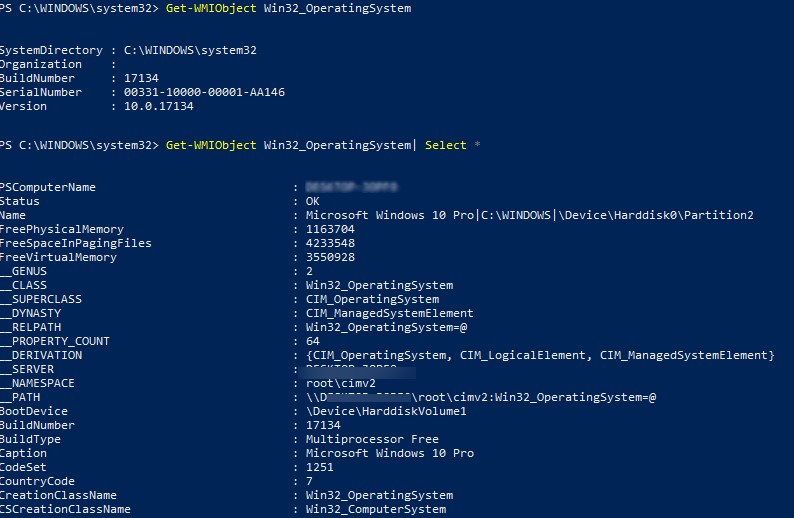
You can use the PowerShell to test WMI filters on a computer. Suppose you have written a complex WMI query and want to check does the computer match this query or not. For example, you created a WMI filter to check for the IE 11 on a computer. You can test this WMI query on the target computer using the get-wmiobject cmdlet:get-wmiobject -query 'SELECT * FROM CIM_DataFile WHERE path="\\Program Files\\Internet Explorer\\" AND filename="iexplore" AND extension="exe" AND version LIKE "11.%"'
If this command returns something, then the computer meets the query conditions. If the get-wmiobject command returns nothing, the computer doesn’t match the WMI filter query.
For example, running the specified command on a computer with Windows 10 and IE 11, the command will return:
Compressed : False
Encrypted : False
Size :
Hidden : False
Name : c:\program files\internet explorer\iexplore.exe
Readable : True
System : False
Version : 11.0.17134.1
Writeable : True

This means that IE 11 is installed on the computer and a GPO with such a WMI filter will be applied to this computer.
So, we looked at how to use WMI filters to apply GPOs only to computers that meet the different WMI queries. It is necessary to take into account the presence of WMI filters when analyzing the reasons for which the certain GPO is not applied on the computer.


